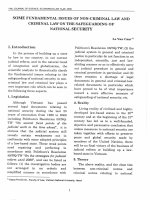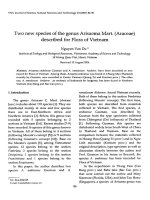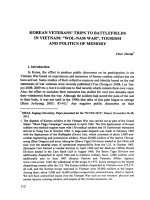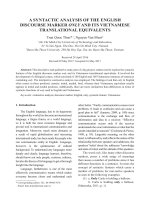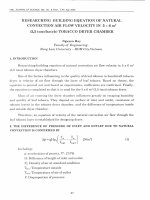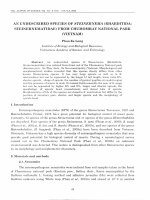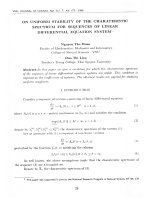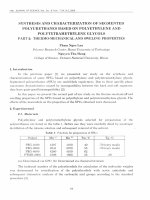DSpace at VNU: Sol-gel spin-coating preparation of Zno:In films with highly C-axis orientation
Bạn đang xem bản rút gọn của tài liệu. Xem và tải ngay bản đầy đủ của tài liệu tại đây (316.04 KB, 7 trang )
VNU. JOURNAL OF SCIENCE.Mathematics - Physics. T.xx, N01 - 2004
SOL-GEL SPIN-COATING PREPARATION OF ZNO:IN FILMS
WITH HIGHLY C-AXIS ORIENTATION
P h u n g Q u o c B ao, K h u c Q u a n g D at, N g u y e n T h i e n H u o n g
College o f N atura l Sciences, Vietnam National University, Hanoi
A bstract: The c-axis oriented ZnO:In films were prepared by the sol-gel spin-coating
process using zinc acetate 2-hydrate, ethylene glycol, indium nitrate 9-hydrate,
triethylamine as starting materials. The preferred orientation of the films increased
with heat treatment temperature. Near u v and green photoluminescent emisions
from the films was observed at room temperature. The PL intensity was found to be
greatly dependent on post-deposition heat treatment. Influence of the multilayer
deposition on XRD analysis and PL characterisation was also discussed.
1. I n t r o d u c tio n
Doped and undoped ZnO are of great in te re s t for many potential
applications in optoelectronic devices due to th eir physical properties, low cost and
the various fabrication techniques (See Ref. [1, 2] for reviews). Depending on the
specific applications, ZnO and doped ZnO films can be p rep ared by a variety of
deposition techniques such as sp u tterin g [3], chemical vapor deposition [4], spray
pyrolysis [5 6 ], pulsed laser ablation [7], charge liquid clu ste r beam [8 , 9], sol-gel
process [ 1 0 - 12 ].
From a practical standpoint, the sol-gel process is an attrac tiv e technique
and has the ad v an tag e s of easily controlling the film composition and easily
fabricating a large-area film with low cost. Most of the stud ies recently reported
have been focusing on ZnO films doped with A1 or In. In a previous p aper [13], we
proposed the p rep a ratio n of ZnO:Al films by sol-gel process.
The sol-gel method, however, has the disadvantage of req u irin g high heating
te m p e ra tu re s for crystallization. Searching for an ap p ro p riate h e a t tre a tm e n t
process is one of resea rch topics on this deposition technique.
The aim of th is work is to develop a n o th er sol-gel-derived doped ZnO/ZnO: In
in order to get b e tte r u n d e rstan d in g how the p rep aratio n procedure governs the
crystalline s tru c tu re and influences the optical properties of the obtained films.
Special a tten tio n h a s been paid to the XRD analysis and photolum inescence spectra
of this m aterial.
2. E x p e r i m e n t a l d e t a i l s
The sta rtin g m ateria l used in the present study was zinc acetate 2-hydrate
(ZnAc 99 9% purity). The solvent was ethylene glycol. The sol stabilizer was
7
8
P hung Quoc Bao , Khuc Quang Dat, Nguyen Thien Huong
trie th y la m in e . The ZnAc was first dispersed into ethylene glycol and th en the
indium n itr a te 9-hydrate was added. The m ixture was m agnetically stirred, and
m oderately h eated a t 100°c to 115°c till to obtain a uniform tra n s p a r e n t solution.
This precursor solution was th en kept at 115°c of about 30 min to avoid the rec rystallisation of ZnAc. Once prepared, the solution was preserved in a herm etic
flask to keep stable and clear for a long period. The final concentration of the
precursor solution was 1,0 mol/1 corresponding to the m olar ratio n In: nZn= 3%.
The precursor solution was readily gels on addition of a few drops of
triethylam ine (1 mol equivalent) to obtain the coating solution. The adding of
triethylam ine is to a ssist hydrolysis of zinc acetate. Excessive addition of
triethylam ine, however, produced sizeable gel particles. The a s-tre ate d solution
became milky and useless. It was needed to remove sm all air bubble from the
coating solution by ultrasonication.
As a s u b s tra te m aterial, we used a well-polished borosilicate glass plate
20x20x1 mm in size. After cleaning the sub state with distilled w ater and acetone
successively in an ultrasonic bath, it was dried with hot air and preserved in a
desiccator before use.
The spin coating procedure was as follows: dropping the coating solution
(approx. 0 , 2 ml) onto the su b stra te, w aiting for a uniform sticky expansion, spincoating w ith 3000 rev.m in 1 for 30s in air. The as-deposited film was dried in air at
room te m p e ra tu re for 15h and th en annealed in a ir in a Lenton electric furnace at
various te m p e ra tu re s for 2h. This h e a t tre a tm e n t decomposed and oxidized the asdeposited films so as to produce ZnO:In films. We have rep e ate d several cycles of
the spin-coating - drying - an nealin g process to obtain m ultilayered ZnO:In films
with various thickness. The films prepared by rep eatin g the spin- coating and
postheating more th a n 3 tim es were considerably opaque a n d th u s not appropriate
to neasurem ents.
The crystalline stru c tu re of the films u n d er investigation was confirmed by Xr a v diffraction (XRD) analysis using CuKa radiatio n with a Brucker Siemens 5000
diffractometer. Photolum inescence spectra were recorded a t room te m p e ra tu re with
a Jobin-Yvon spectrofluorom eter FL3-22 using a XFOR-450 Xe lam p as a u v light
source.
3. R e su lts a n d d i s c u s s i o n
Fig.l shows XRD p a tte rn s of single-layered ZnO:In films after the h eat
treatm ent at 220-520°C. A very broad peak around 29 = 22° is due to the glass
substrate. No o ther phases are detected und er the p resen t experim ental condition.
T\eve is no evidence of any residual In compound in the films. Typical peaks caused
by crystalline ZnO are observed for the films th a t were ann ealed at more than
Sol - gel spin-coating preparation of ZnO:In films .
9
2 0 0 °c. The h ig hest peak appears around 29 = 34° corresponding to the diffraction
by a (002) plane of ZnO
increasing the a n n ea lin g
sm aller but still a p p ea r in
Relative intensities of the
tab u late d in T ab .l.
crystal. In tensity of the (002) peak is increased with
te m p era tu re , w hereas the ( 100 ) and ( 101 ) p eak s £et
the XRD p a tte rn of the film t h a t was an nealed a t 520°c.
th ree XRD peaks at various a n n ealin g te m p e ra tu re s are
Fig. 1. XRD pa ttern s of single-layer ZnO:In films at
220°c
520°c
(a);
420°c
(b);
320°c (c);
(d) a n n ealin g tem p era tu re s
Tab. 1. Relative intensities of the (100), (002) and (101) XRD peaks
at various annealing tem peratures
10
P h u n g Quoc B ao , K huc Q u a n g Dat, N guyen Thien Huong
XRD p a tte r n s of single- a n d double-layered film s a n n e a le d a t 520°c are shown
in Fig.2. No o th e r diffraction peak s a p p e a r in th e 3-layerecl film ’s p a tt e r n except the
(002). H igh er degree of th e c-axis o rien tatio n is found for th e films with several
coatings. It is well know n t h a t the o rien tatio n of c ry stals in th e film is strongly
d ep en d en t on th e c ry stallo g ra p h y of the su b s tra te . In th e single-layered films, the
p refe ren tial o rie n ta tio n m ay occur via nucleation a t th e film/ s u b s tr a te interface
and th e ran d o m atom ic a rr a n g e m e n t of the glass s u b s tr a te pro bably d istu rb s the
oriented c ry stal growth. T herefore, the (002) peak in te n s ity w as r a t h e r weak. In the
second (third) layer, th e o rien ted c ry stal grow th m ay easily ta k e place onto the
slightly o rie n te d c ry stals of th e first (second) layer. As a re s u lt, th e re le v a n t (0 0 2 )
peak in te n sity in creases. The (100) an d (101) peak in te n s itie s for th e 2-layered
films a re also w e a k e r t h a n those for the single-layered ones.
Fig. 2. XRD p a tte rn s of 2-layered (a) and single-layered (b) ZnO:In films
annealed at 5200C
Zinc oxide ex h ib its two k in d s of PL emissions: one is a n u ltra v io le t near-bandedge em ission a t a p p ro x im ativ ely 380 nm a n d the o th e r in a visible deep-level
emission w ith a peak a n y w h ere in the range 450-730 nm (VisPL). The visible
em issions a re re la te d to in trin sic defects or d o p a n ts in ZnO c ry s ta l and depend
greatly on the p r e p a r a tio n m ethod s a n d conditions.
Sol - gel spin-coating preparation of ZnO:In films.
11
The ph otolum inescence sp ectra at room te m p e r a tu re excited w ith th e 325-nm
line of XFOR Xe lam p for the single-layered films a n n e a le d a t 220°-520°C are
displayed in Fig.3. T he common fe a tu re is t h a t PL sp e c tru m consists of 2 distinct
bands: a n e a r u v em ission a t ~ 380 nm and a green em ission a t ~ 508 nm. The
former called excitonic b a n d is probably caused by th e decay of an exciton lying
about 40 meV below th e conduction b an d edge in ZnO [14, 15]. The l a tte r is
originated from th e oxygen vacancy [16]. Both excitonic a n d green b a n d s were
observed mostly in c re a sin g w ith th e a n n e a lin g te m p e r a tu r e for all sam ples.
Fig.3. Photolum inescence spectra for the single-layered films
a t various annealing tem p era tu re s
It should be noted t h a t excitonic ph otolum inescence is very sensitive to the
quality of c ry stal s tr u c tu r e s a n d to th e presence of defects. T he m ore perfect is the
crystal and th e m ore s u b s titu tio n a l is the im p u rity a sso ciatio n in th e m ain lattice,
the more probable is th e o bserv atio n of excitonic PL. F ig .4 illu s tr a te s two PL
spectra: one for th e single-layered film, th e o th e r for th e 2-layered film. The
excitonic PL em issio n in te n s ity increases a b ru p tly for th e 2-layered films. All the
above-m entioned show s t h a t th e discussion on PL sp e c tra is com patible w ith t h a t
on XRD a n aly sis for th e a s-p re p a re d ZnO:In films.
P h u n g Quoc Bao , Khuc Quang Dat , Nguyen Thien Huong
12
X 104
Fig.4. Photoluminescence spectra for 2-layered (a)
and single-layered (b) films annealed at 520°c
4.
C o n c lu s io n
In-doped ZnO films have been deposited by the sol-gel spin - coating m ethod
onto glass su b stra tes. The XRD p a tte rn analysis has been stu d ied u n d e r different
post-deposition h e a t tre a tm e n t conditions. PL spectra with a n excitonic emission
and a broadband green emission u n d e r u v excitation compatibly reflect the change
of the film m icrostructu re and crystallite o rientation observed in XRD experim ents.
It app ears th a t the preferentially oriented crystallites of th e films plays an
im portant role in th e ir optical spectroscopic properties. F u r th e r investigations on
electrical properties of the films are necessary to confirm th e used p rep aratio n
procedure and will soon be reported.
i•
References
1.
S. A. Studenikin, N. Golego and M. Cocivera, J. App. Phys., 84, (1998), 2287.
Sol - gel spin-coating preparation of ZnO:In films..
13
2.
D. c. Look, M aterials Science and Engineering B80(2001), 383.
3.
M. Tzolov, N. Tzenov, D. Dimova-Malinovska, M. Kalitzova, c . Pizzuto,
Vitali, G. Zollo and I. Ivanov, T hin Solid F ilm s , 379(2000), 28.
4.
H. Sato, T. Minami, T. Miyata, s. Takata and M. Ishii, T hin Solid Films
246(1994), 65.
5.
M. Krunks
6.
A.S. Riad, s . A. M ahm oud and A. A. Ibrahim , Physica B Conden. Mat.,
296(2001), 319.
7.
K. L. Narasimhan, s. p. Pai, V. R. Palkar and p. Pinto, T h in So lid F ilm s ,
295(1997), 104.
8.
c . K. Ryu a n d K. Kim, App. Phys. Lett., 67(22) (1995), 3337.
9.
M. Koyano, P h u n g QuocBao, Le Thi T hanhB inh, Le HongHa, Nguyen NgocLong
and S. K atay am a, Phys. Stat. Sol. (a) 193, No. 1(2002), 125
G.
and E. Melikov, T hin Solid F ilm s, 270(1995), 33.
10. Y. N atsum e a n d H. S ak ata, T hin Solid Films, 372(2000), 30.
11 . S. F u jihara, H. Naito and T. Kim ura, Thin Solid F ilm s 389(2001), 227.
12. M ikrajuddin, F. Isk a n d ar, K. O kuyam a and F. G. Shi, J. Appl. P h y s 89(2001),
6431.
13. P hung Quoc Bao, Khuc Quang D at and Nguyen Trong Nghia, VNU. J. Sci
M a th .-P h y s., T. XIX, No. 1(2003), 16.
14. A.A. Gladyschuk, J. Lumin.y 42(1988), 49.
15. T. v. Butkhuzi, T. G. Chelidze, A. N. Georgobiani, D. L. Jashiashvili, T. G.
K hulordava and B. E. c . Tsekvava, Phys. Rev. B58(1998), 10692.
16. F. H. Leiter, H. R. Alves, A. Hofstaetter, D. M. Hofmann and B. K. Meyer, Phys.
Stat. Sol. (b) 226(2001), R4-R5.
